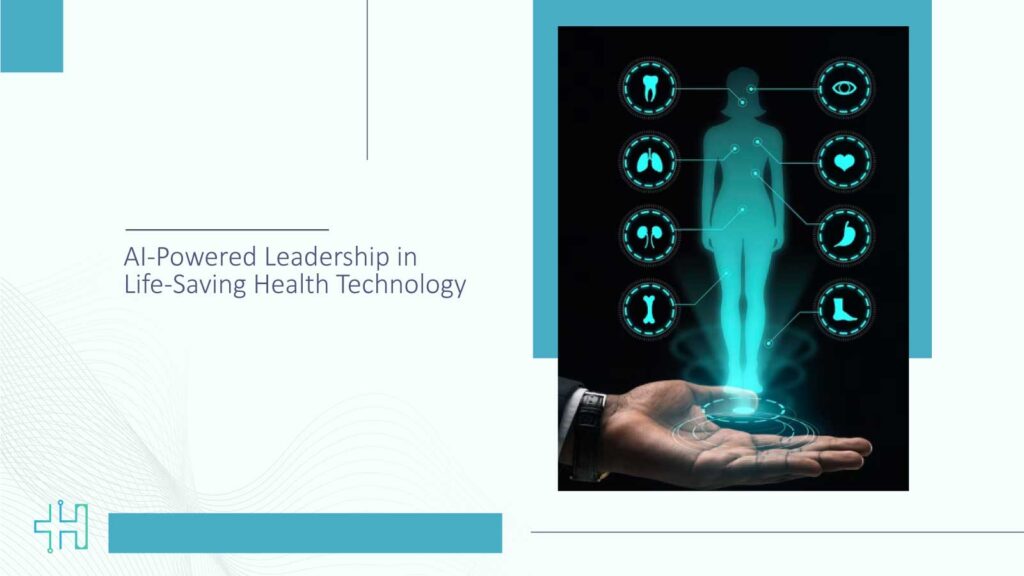In moments when every heartbeat matters, who should we trust more: human instinct sharpened by years of practice, or machine intelligence fueled by endless data? The real answer isn’t one or the other. It’s the rise of AI-powered leadership in life-saving health technology, where visionary leaders are weaving empathy and algorithms together to create care that is faster, smarter, and deeply human.
This is more than just technology in action; it’s leadership that ensures innovation is aligned with humanity’s greatest need: saving lives. In this article, we’ll explore how AI-powered leadership is reshaping diagnostics, streamlining hospital operations, and even predicting global health risks. We’ll also uncover the leadership qualities that allow health technology to deliver real impact without losing its human soul.
Why AI-Powered Leadership Matters Now
Healthcare today is at a crossroads. On one side, we face rising demand from aging populations, clinician shortages, and mounting administrative complexity. On the other hand, we have artificial intelligence capable of analyzing vast amounts of data in seconds, surfacing insights that can save time, resources, and lives. The bridge between these two realities is AI-powered leadership in life-saving health technology.
Without clear leadership, AI risks becoming another shiny tool. With it, AI transforms into a force that enhances care delivery and strengthens health systems. IBM’s 2024 AI in Healthcare report found that 77% of healthcare executives believe AI provides a competitive advantage, and nearly 34% already use it to streamline revenue-cycle management, freeing clinicians from red tape so they can focus on patients.
The timing couldn’t be more critical. The World Health Organization estimates a global shortfall of 10 million health workers by 2030. Leadership that can deploy AI responsibly, automating administrative load, accelerating diagnoses, and augmenting decision-making, ensures patients continue receiving not just care, but the right care at the right time.
Real Innovations Changing Lives
AI in healthcare isn’t just a future promise; it’s already saving lives in real, tangible ways. From early disease detection to hospital efficiency and even global epidemic forecasting, the impact is both immediate and profound. Here’s how AI-powered leadership in life-saving health technology is shaping real-world breakthroughs.
Leadership Traits That Make It Work
Technology alone doesn’t save lives. It takes leaders with vision, integrity, and discipline to transform AI into tools that truly serve patients. The most effective healthtech leaders aren’t just adopting algorithms, they’re embedding them within a framework of trust and purpose.
Purpose-Driven, Patient-Centered Vision
At its core, AI-powered leadership in life-saving health technology is about aligning innovation with patient needs. Leaders who place human outcomes above short-term gains build technologies that last. A recent market analysis estimates healthcare AI will grow from $14.5 billion in 2023 to nearly $148 billion by 2029, fueled by leaders who see AI as a partner in advancing care rather than just a cost-saving mechanism.
This kind of leadership reframes the narrative: AI is not a competitor to clinicians but a co-pilot that extends their reach and strengthens their impact.
Governance, Trust, and Explainability
Healthcare thrives on trust. Patients must believe the systems guiding their care are safe, fair, and transparent. Leaders who succeed in this field embrace governance models that ensure AI is explainable and accountable.
The FUTURE-AI framework offers six guiding principles: Fairness, Universality, Traceability, Usability, Robustness, and Explainability, supported by 28 best practices for every stage of the AI lifecycle. Leaders who internalize such frameworks ensure their organizations don’t just deploy AI, they deploy AI that patients and practitioners alike can trust.
Bridging Empathy with AI: A Human Touch
Healthcare leadership isn’t just about efficiency or scale; it’s about preserving humanity at the heart of care. Patients remember how they were treated more than the test result they received. That’s where the real magic of AI-powered leadership in life-saving health technology lies: blending empathy with precision.
Imagine a busy clinician at the end of a 12-hour shift. Instead of drowning in discharge notes, they can leave the paperwork to an AI transcription system and spend those final moments holding a patient’s hand, answering their questions, or simply offering comfort. Tools like ambient documentation platforms are already making this possible, raising $243 million in funding to accelerate adoption.
It’s not just about saving time; it’s about saving energy for the most human part of medicine: compassion. Leaders who prioritize this balance ensure that AI enhances, rather than replaces, the human touch.
Consider elder care. AI-driven companions are being used to support seniors with reminders, cognitive engagement, and even moments of connection. These technologies don’t substitute for human relationships, but they reduce loneliness and give caregivers peace of mind.
The same principle extends to public health innovation. From mapping healthcare access in underserved nations to distributing AI-powered home health kits that reached half a million households, leadership ensures that empathy guides every deployment.
Because in the end, patients don’t remember whether AI was involved in their care, but they do remember that they were seen, heard, and valued.
The True Calling of AI-Powered Leadership
We are entering an era where technology is a partner in saving lives. The power of AI-powered leadership in life-saving health technology rests not in algorithms alone but in the vision and values of those who guide them. When leaders champion transparency, empathy, and evidence-based adoption, AI becomes more than innovation; it becomes a lifeline.
For healthtech leaders, policymakers, and decision-makers, the question is no longer if AI will shape the future of care, but how you will lead its integration. Will it be deployed as a cold, mechanical process, or will it serve as a bridge between humanity and technology?
The future of healthcare depends on leaders who choose the latter, those who weave compassion into code, ensure governance keeps pace with innovation, and never lose sight of the patient at the center. That is the true calling of AI-powered leadership: to create a healthcare system that is faster, smarter, and above all, more human.
FAQs
1. What does AI-Powered leadership in life-saving health technology involve?
It’s about leaders guiding the use of AI in ways that improve care outcomes, strengthen trust, and ensure technology always serves human needs first.
2. How does AI-powered leadership differ from simply adopting AI tools?
Adopting tools is tactical. Leadership means setting vision, ethics, and governance so AI improves care responsibly and sustainably across the health system.
3. Can AI free up doctors and nurses to spend more time with patients?
Yes. By automating tasks like documentation, coding, and scheduling, AI allows clinicians to focus more on meaningful, face-to-face patient care.
4. What role does empathy play in AI-powered leadership?
Empathy ensures AI is not just efficient but human-centered. Leaders who prioritize empathy balance technical innovation with compassion in care delivery.
5. Where is AI making the biggest impact in healthcare today?
AI is transforming diagnostics, hospital operations, and public health. It’s spotting early disease, easing administrative burdens, and even predicting outbreaks.
Dive deeper into the future of healthcare.
Keep reading on Health Technology Insights.
To participate in our interviews, please write to our HealthTech Media Room at sudipto@intentamplify.com






